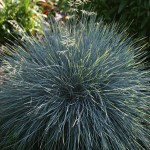 Also known as sheep’s fescue, this cool season perennial grass was orginally native to Europe but has been bred for color, texture, flowering habit, and size and now is represented by over 25 cultivars. It belongs to the grass family, Poaceae, that also includes bamboo, rice, and corn. Plants form dense, fine textured, evergreen or semievergreen clumps 6-12″ tall and can be bright blue to dark green depending on the cultivar. Terminal panicles of flowers appear well above the foliage in late spring to early summer and may be showy or inconspicuous. Atleast one cultivar, however, lacks flowers. When present, the flowers are light green tinged with purple at first but turn buff colored as they mature and are considered unattractive by some gardeners. The plants are drought and pollution tolerant and are very attractive as groundcovers and edgers, and in containers and rock gardens. The plants are short-lived and the foliage may die out in the center in hot humid climates. The genus name, Festuca, is the Latin word for grass stalk or straw. The specific epithet, glauca, is the Latin word meaning having bloom (the fine, whitish, posdery coasting on leaves).
Also known as sheep’s fescue, this cool season perennial grass was orginally native to Europe but has been bred for color, texture, flowering habit, and size and now is represented by over 25 cultivars. It belongs to the grass family, Poaceae, that also includes bamboo, rice, and corn. Plants form dense, fine textured, evergreen or semievergreen clumps 6-12″ tall and can be bright blue to dark green depending on the cultivar. Terminal panicles of flowers appear well above the foliage in late spring to early summer and may be showy or inconspicuous. Atleast one cultivar, however, lacks flowers. When present, the flowers are light green tinged with purple at first but turn buff colored as they mature and are considered unattractive by some gardeners. The plants are drought and pollution tolerant and are very attractive as groundcovers and edgers, and in containers and rock gardens. The plants are short-lived and the foliage may die out in the center in hot humid climates. The genus name, Festuca, is the Latin word for grass stalk or straw. The specific epithet, glauca, is the Latin word meaning having bloom (the fine, whitish, posdery coasting on leaves).
Type: Grass.
Bloom: Inconspicuous pale gold flower heads in June.
Size: 6-10” H x 12”W.
Light: Full sun with afternoon shade in the South.
Soil: Poor, well drained, neutral or slightly alkaline soil.
Hardiness: Zones 5-9.
Care: In early spring cut back the foliage back 1-2” above the crown. Remove seed heads as they develop; the plant will reseed itself but the seedling will vary in color from green to blue. Do not fertilize or over water.
Pests and Diseases: May wane and die off in heat and humidity.
Propagation: Divide in spring or fall; seed of cultivars may not come true in color.
Companion plants: Lovely with pink flowers such as Dianthus spp, cranesbill (geranium spp), evening primrose (Oenothera speciosa) and with the foliage of ‘Burgundy Glow’ ajuga.
Outstanding Selections:
‘Elijah Blue’ (powdery blue foliage, medium texture, 8″ tall)
‘Azurit’ (Azure blue fescue; blue-gray foliage, medium texture, 12-16″ tall)
‘Blaufuchs’ (Bluefinch fescue; blue foliage, fine exture, 6-12″)
‘Daeumling (Tom Thumb fescue; silver-blue foliage becoming green; compact)
‘Fruehlingblau’ (Spring blue fescue; intense blue foliage, fine texture; 8″ tall)
‘Harz’ (Harze Mountain fescue; olive green foliage, weeping, medium texture, 12″ tall
‘Meerblau’ (Ocean blue fescue; new growth bue and green, medium texture, 6-12″ tall)
‘Sea Urchin’ (silvery blue foliage, medium texture, 6-12″ tall)
Silberreiher’ (Silver egret fescue; silvery blue foliage, fine texture, 6-12″ tall)
‘Soehrenwald’ (olive green foliage changes o blue-green as season progresses, medium texture, 8-12″tall)
‘Solling’ (blue-gray foliage becoming red-brown in fall and winter, fine texture, 8″, no flowers)
I have three of the blue/grey Festucas but I’m afraid they never seem to do well here despite what should be ideal conditions. All three are hanging on but not really increasing in size. A pity because they are very impressive when at their best. Some plants are not meant to be, even though I find it hard to accept!
I am surprised to hear that they do not do well with you. They are very pretty here when it is their season (spring to early summer) but they get pretty ratty the rest of the time when temperatures and humidity are soaring.. I love them for what they offer when they are at their best.